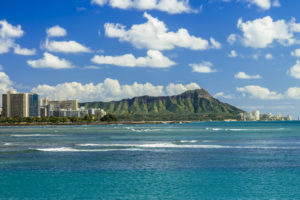
Aloha! This month we travel across the ocean to the island paradise of Hawaii. In the state, you can attend a luau to experience true Hawaiian culture, relax on the beach or hike in one of the many tropical forests or mountains.
Hawaii is unique because it the only state made up of part of the volcanic Hawaiian archipelago, which consists of hundreds of islands spread over 1,500 miles. At the southeastern end of the archipelago are eight islands known as the state of Hawaii. They are: Niihau, Kauai, Oahu, Molokai, Lanai, Kahoolawe, Maui and Hawaii.
Due to its central location in the Pacific Ocean and its 19th-century labor migration, Hawaii’s culture is strongly influenced by North American and Asian cultures, in addition to its indigenous Hawaiian culture. This is exhibited by the many customs and food cuisines that Hawaii has to offer. For example, it is customary to bring a small gift for one’s host (i.e., a dessert). Many Hawaiian plates have been influenced by Polynesian, Asian and American foods as well.
Business Climate
Tourism is a paramount part of the Hawaiian economy. Due to the mild year-round weather, tourism is popular throughout the year. The major holidays are the most popular times for people to visit, especially in the winter months.
Visitors flock to the many state parks that the state has to offer, including Diamond Head State Monument, Hanauma Bay State Underwater Park, Waimea Canyon State Park and Waimea River State Park. For a taste of Polynesian culture, people visit the Polynesian Cultural Center and for history, people visit the USS Arizona Memorial at Pearl Harbor. (December 7th, of course, is nationally recognized as Pearl Harbor Day.)
The state’s food exports include coffee, macadamia nuts, pineapple, livestock, sugarcane and honey. Hawaii’s consistent climate has attracted the seed industry (i.e., corn), which is able to produce three generations of crops per hear on the islands, compared with one or two on the mainland. Seeds yielded $264 million in 2012, supporting 1,400 workers.
Tax Climate
Hawaii’s individual income tax system consists of nine brackets with a top rate of 8.25%. The top rate ranks 8th highest among states levying an individual income tax. Hawaii’s state and local tax collections per person were $1,232 in 2013, which ranked 14th highest nationally.
Hawaii’s corporate tax system consists of three brackets with a top rate of 6.4%. The top rate ranks 30th highest among states levying a corporate income tax. Hawaii’s state and local corporate income tax collections per person were $88 in 2013 which ranked 39th highest nationally.
The state levies a 4% general excise tax (GET), a tax similar to sales tax in other states but much broader in its application. Businesses are subject to GET on their gross receipts from doing business in Hawaii. A sales tax is a tax on customers whereas GET is a tax on businesses. Also, businesses are required to collect sales tax from their customers whereas businesses are not required to collect GET from their customers. The average local sales tax rate is an additional 0.4%. Hawaii’s state and local governments collect $2,214 in general sales taxes and $868 per person in excise taxes, for a combined figure of $3,082, which ranks 1st highest nationally. Hawaii’s gasoline tax stands at 42.35 cents per gallon, 4th highest nationally, while its cigarette tax stands at $3.02, 5th highest nationally.
Hawaii’s state and local governments collected approximately $943 per person in property taxes in 2013, which ranks 38th nationally.
Tax Incentives and Credits
Tax credits provide incentives to support business growth and activities in Hawaii. These include:
20-25% Motion Picture, Digital Media and Film Production Income Tax Credit- This is a refundable tax credit based on a production company’s Hawaii expenditures while producing a qualified film, television, commercial or digital media project. The credit equals 20% of qualified production costs incurred on Oahu, and 25% on the neighboring islands (i.e., the Big Island, Kauai, Lanai, Maui and Molokai).
Corporate Tax Credit for Solar and Wind Energy- The Hawaii Energy Tax Credits allow individuals or corporations to claim an income tax credit of 20% of the cost of equipment and installation of a wind system and 35% of the cost of equipment and installation of a solar thermal or a photovoltaic (PV) system.
For more information on these tax credits, the Hawaii Film Office and the Hawaii State Energy Office has more information to help you get started.
Our team at Miles Consulting Group is always available to discuss the specifics of your situation, whether in Hawaii or other U.S. States, and help you navigate the complex tax structures arising from multistate operations. Call us to help you achieve the best tax efficiencies.
Random Facts
- Hawaii has beaches with gold, red, black and even green sand.
- The state does not observe daylight savings time.
- The state’s coastline is 750 miles long, the fourth longest in the U.S. after the coastlines of Alaska, Florida and California.
- It is the 8th smallest and the 11th-least populous state, but the 13th-most densely populated of the 50 states.
- The Hawaiian archipelago is part of the Polynesian Sub region of Oceania.
- Hawaii’s tallest mountain, Mauna Kea, is 13,796 feet above sea level. If measured from the base of the mountain, which lies on the floor of the Pacific Ocean, the mountain is about 33,500 feet tall, which is taller than Mount Everest.
- Hawaii is the only state where coffee is grown.
- Hawaii is the only state to have never recorded a sub-zero Fahrenheit temperature.



















